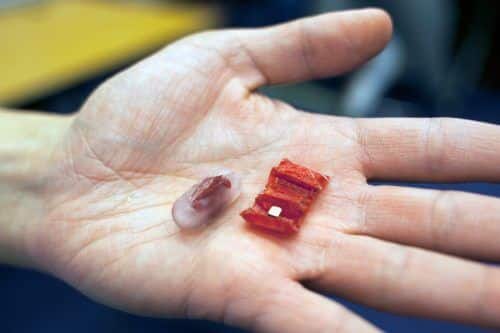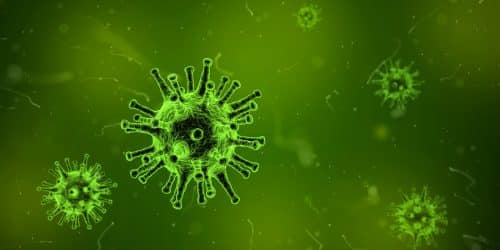Five ideas that may solve problems and improve the lives of all of us: an effective drug against viruses; Robots in a pill; computerized recognition of visual patterns; quantum communication satellites; Completely new antibiotic drugs

See previous episodes in the series:
- Supermolecules consisting of atoms not found in the periodic table
- Software for locating poverty centers
- Batteries that can remove carbon from the atmosphere
- Clothes that will cool the wearer
The combination of the words "that will change the world" is a bit worn out. And yet, how else can one fully describe the historical impact of inventions such as the transistor, the Internet, or the cell phone? There are ideas that really shape history. It is still too early to tell with batteries that trap carbon dioxide, robots that can be swallowed with a pill or quantum satellites and seven other ideas that we have published in recent weeks and in this article, will bring about a similar change. Most plans fail, and the biggest ideas are also the ones with the biggest risks. But the distance between a ridiculous idea and a necessary idea is short. And some of these ideas may make a difference.
An effective anti-viral drug
A rare genetic mutation could help develop the first drug to treat a wide range of viral infections
By Annie Sneed
Viruses, or viruses, are notorious for their resistance to man-made drugs. But it turns out that they are helpless in the face of a rare mutation in the gene ISG15. Carriers of this mutation deal more successfully with most viruses (and perhaps with all of them) that harm the members of the human race. But the mutation is rare: one in 10 million people carries it. Dusan Bogunovic from the Icahn School of Medicine at Mount Sinai Hospital believes that it may be possible to develop a drug that mimics this mutation. If he is right, he may be close to developing a pill that will give patients the temporary ability to successfully fight off any type of virus without getting sick. The drug will also give people who take it immunity for the rest of their lives to all the strains of viruses to which they were exposed during treatment with the drug (unless the viruses undergo new mutations, such as those that the flu virus undergoes).
To understand how the mutation suppresses the viruses and how a drug could mimic it, Bogunovich and his team recruited six people who carry this mutation. They analyzed their DNA sequence and isolated blood and skin cells from some of them. After that, the researchers exposed skin cells of three of the people to different viruses, including influenza and herpes viruses. After 24 hours, the number of copies of the viruses in these cells was several times smaller than in normal cells. The team explained the reason for thisIn the article In May 2016 in the journal Nature Communications: the mutation in the ISG155 gene blocks a process that helps reduce inflammation. Inflammation helps the body fight viruses, so these people are "a little more prepared than you or me for the virus they're contracting," Bogunovich says. As a result, their bodies fight off invading viruses and develop immunity before the viruses can replicate and multiply enough to make them sick.

Bogunovich wants to find a drug that mimics the effect of the mutation in the ISG15 gene. "A subtle change in the system could give us control over the first outbreak of the infection," he says. As part of the search for a successful antiviral drug, Bogunovich's group is currently testing 16 million compounds. After promising compounds are found, the team will have to improve their chemical composition, conduct toxicity tests and experiments on animals, and finally conduct clinical trials on humans. There is no guarantee of success. Some of the carriers of the mutation in the ISG15 gene periodically suffer from attacks and develop the first signs of an autoimmune disease similar tolupus, and the future drugs, which may be found, must not cause such side effects. (According to the researchers, using the drug for a limited time can help avoid them.) Bogunovich began working on establishing a biotechnology company based on his research. "Nothing is impossible," he says. "It's a process, but I think this process is extremely exciting."
Robots in a pill
Robots that fold using the origami method and are operated remotely will make it possible to perform medical procedures inside the body
by John Paulus
The prevailing impression is that the more advanced a medical intervention is, the less invasive it is. Bariatric surgeries Treatment of obesity, for example, used to involve opening the abdomen, from the navel to the diaphragm. Today, such surgeries are performed using the method laparoscopically, through cuts that do not exceed a few centimeters in length. Now researchers from the Massachusetts Institute of Technology (MIT) have built a prototype of a robot capable of performing simple procedures inside the stomach without any incisions at all and without the need for connection to external equipment: the patient simply swallows the robot.
The robot enters the digestive system wrapped in an ice cube and makes its way towards the stomach. The ice melts, and the robot unfolds like origami. At this point the robot looks like a crumpled sheet of paper. It moves thanks to folds, grooves and patches, which are located at key points on the "page", and expand and contract when exposed to heat or magnetic fields. These movement points work together like joints and muscles. Surgeons can steer the robot from the outside using electromagnetic fields acting on a magnet integrated into the robot's body. The robot can also crawl to the place it is supposed to reach by stretching the folds of its body against the walls of the stomach in a movement called "Sticking and sliding".
The body of the robot consists of materials suitable for operating in a biological environment. Part of it is made of pig intestine (like a sausage casing) and is capable of carrying medicine to internal wounds or dressing them by sticking to the wound like a plaster. It can also use its magnet to pick up and expel foreign bodies, such as a swallowed watch battery.
The robot has not yet been tested on humans or animals, but Daniela Ross, the robotics engineer whose research group is building it, sees it as a successful demonstration of the possibility of building "robots with even more capabilities" that may in the future include sensors that will enable the detection of internal bleeding. The ability to remove objects without traumatic surgery would be a tremendous advance. "In the 70s, my father had a kidney stone, and then they just cut open half of his body to get this thing out," says Ross. "It will be a few more years before these tiny robots can be used, but if that happens, imagine the implications for these procedures."
How robots fold:
https://www.youtube.com/watch?v=jS2eW6FBpG4
Computerized recognition of visual patterns
A new approach to artificial intelligence allows computers to recognize visual patterns better than humans
John Paulus
If you were shown a single letter from an unfamiliar alphabet and asked to copy it on a piece of paper, you would probably succeed in doing so. A computer, on the other hand, would not have been able to cope with the task, not even a computer equipped with the best algorithms forDeep learning Like the ones Google uses to catalog images. In order to succeed in even the simplest and crudest distinctions between images, such systems need to undergo training based on huge amounts of data. They may be suitable for machines in post offices that sort letters by zip code, but where sharper distinctions are needed, such as in real-time translation between languages, an approach based on learning from a limited number of examples can be much more effective.
The leap that computers need to make to succeed in such tasks is now a more realistic possibility thanks to a machine learning framework called "Bayesian software learning" (BPL). A team of researchers from New York University, the Massachusetts Institute of Technology (MIT) and the University of Toronto showed that in recognizing and repeating unfamiliar handwritten characters, a computer using BPL can outperform humans after exposure to a single example. (the approachBayesian” is a way of probabilistic inference that can be used to update uncertain hypotheses based on new information.)
The BPL approach to machine learning is fundamentally different fromDeep learning” which is nothing more than a rough model of the human brain's ability to recognize patterns. The source of inspiration for BPL, however, is the ability of the human mind to plan a series of actions that can reproduce a given pattern. For example, thanks to this ability, the brain can understand that it is possible to build the letter A by drawing a slanted line and two vertical lines coming out of it. "The computer represents the letter A by building a simple computer program that generates different versions of the letter every time the code runs," says Brendan Lake, an information researcher from the Moore and Sloan program at New York University who participated in the research. Bayesian processing allows the software to deal with the uncertainty of creating unfamiliar letters from smaller parts that are already familiar to it (like one of the vertical lines in the letter A, for example).
This type of machine learning is more flexible and efficient learning. The process that the BPL software uses to analyze an unknown character and then reconstruct it could one day help artificial intelligence applications reach conclusions about cause and effect patterns in complex phenomena (such as the flow of a river) and then use them to treat completely different systems. Humans often usehorizontal thinking” abstract of this kind. BPL could impart a similar capability to computers. "We are trying to create computers that will be able to learn concepts that can then be applied to many other tasks and fields," says Lake. "This is one of the core aspects of human reason."
Researcher Brendan Lake explains how the Bayesian pattern recognition software was developed:
https://www.youtube.com/watch?v=shT-dFKU2WA
Quantum communication satellites
Transmission of quantum encryption keys from space may make the Internet immune to hacking
John Paulus
Completely secure encryption does not require any technology more exotic than paper and pencil: a random string of letters and numbers is chosen to serve as a key for an encrypted message. Write the key on a piece of paper, use the key once, and then burn the paper. The important thing is to ensure that no one intercepts the key and does not change it. And on the Internet all the time keys are stolen and maliciously changed.
quantum key exchange (QKD) solves the problem by creating a one-time key fromEntwined photons, that is, from two light particles whose quantum states are related to each other. Any disturbance in one of them is immediately reflected in the other regardless of the distance between them. The problem with quantum key switching is that no one has yet found a way to transmit entangled photons over great distances. But in August 2016, the Chinese Academy of Sciences took a big step towards solving the problem when it placed the world's first quantum satellite into orbit around the Earth.
The program, called "quantum experiments on a spatial scale" (QUESS), is held in collaboration with the Austrian Academy of Sciences. The idea is to use a satellite to transmit quantum keys to two observation points at different ends of China that are separated by 1,200 kilometers, more than eight times the greatest distance that researchers have managed to achieve so far. according to Anton Zeilinger, who led the team that achieved the previous record in 2012, and now works in collaboration with his former student, Pen Xian-wei, who serves as the chief scientist of QUESS, a platform in space is the only option: "There is no place on Earth that has a line of sight of 1,000 kilometers." Zeilinger is a physicist who serves as a consultant to the Scientific American system.

If the Chinese researchers set a new distance record, satellites could be used in the future as platforms that circle the Earth and make it possible to create a "break-proof" Internet where the laws of physics will guarantee the security of encrypted information packages. "We hope to build intercontinental quantum communication," says Zeilinger. "This is not just a science fiction idea. This is how computers will communicate with each other in the future."
Note: Since Writing the news The Chinese satellite set a new record of distance in the transmission of entangled photons
Completely new antibiotic drugs
A method for building new compounds may defeat drug-resistant bacteria
Annie Sneed
It is hard to imagine a world without antibiotics, but due to widespread overuse, this is the direction we are heading. According to the US Centers for Disease Control and Prevention (CDC), every year in the US alone more than 23,000 people die from infections that antibiotics can no longer cure. A study commissioned by the British government estimated that by 2050 there will be 10 million deaths a year worldwide as a result of antibiotic resistance. Scientists are struggling to develop new drugs that will kill these superbugs. Take for example the main group of antibiotic drugs, theMacrolides. These drugs are used to treat common bacterial infections, including those that cause pneumonia, throat infections, ear and skin infections, and sexually transmitted diseases.
While attempts are being made to update the chemical structure of these antibiotic substances to improve their effectiveness against resistant strains, so far researchers have not had much success. It is difficult to change the chemical structure of macrolides. The raw materials necessary for their preparation are produced in large tanks of industrial bacteria, and it is a process that is not easy to make subtle and precise changes. "The chemists have been at a loss for several decades," he says Andrew Myers, professor of chemistry and chemical biology at Harvard University.
But recently Myers and his team found a practical way to build macrolides in the lab, step by step. To do this, they divided the structure of the macrolides into eight simple building blocks and then they reassemble them in different forms and in the process slightly change their chemical structure. in the article they published Meyer and his group in May 20166 in the journal Nature they reported their success in synthesizing more than 300 new compounds. When they were tested on 133 types of disease-causing bacteria, most of the compounds inhibited the bacteria, and some of them were able to overcome drug-resistant strains.
Since then, researchers have created more than 500 new compounds, and Myers founded a company named Macrolide Pharmaceuticals, and its purpose is to bring the drugs produced in the process to the market. The group started working on two more antibiotic groups, lincosamides וAminoglycosides. Only a few of the compounds they create will eventually be useful as antibiotic drugs, and a long time will pass even before these drugs reach pharmacies. But Myers hopes studies like his will help defeat superbugs. "I am completely optimistic that as we continue to research, the results will only get better and better," he says.
